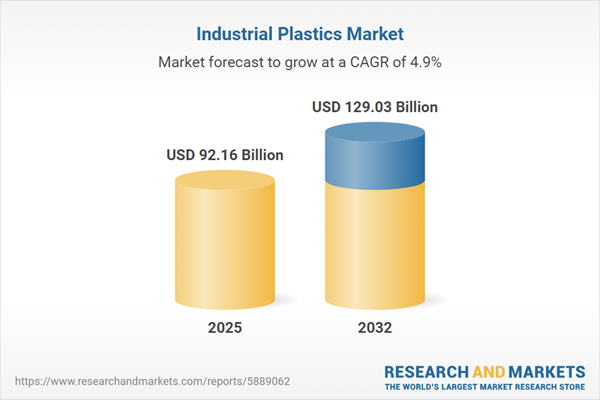Speak directly to the analyst to clarify any post sales queries you may have.
Business leaders in the industrial plastics market are navigating a period of accelerated transformation where sustainability, regulatory adaptation, and digital innovation drive decision-making. Staying competitive requires actionable strategies that meet emerging environmental and supply chain demands, while reinforcing long-term resilience across multiple sectors.
Market Snapshot: Industrial Plastics Market Size and Growth Drivers
The industrial plastics market reached USD 87.78 billion in 2024, with projections of USD 92.16 billion in 2025 and further growth to USD 129.03 billion by 2032, supported by a compound annual growth rate of 4.93%. Expansion is underpinned by sustained demand in industries such as automotive, construction, packaging, and healthcare. Companies prioritizing advanced resin technologies and the digitalization of supply chains enhance their ability to respond to regulatory and end-user shifts. These capabilities allow industry players to manage evolving market pressures with greater agility, an imperative for executives who are molding strategies in a dynamic landscape.
Scope & Segmentation: Comprehensive Industrial Plastics Market Insights
- Resin Types: PET is a preferred choice for strong packaging and clear films. Grades of polyethylene—including HDPE, LDPE, LLDPE, and UHMWPE—serve flexible applications across sectors. Polypropylene meets technical and automotive requirements effectively. Polystyrene types like EPS, GPPS, and HIPS are vital for packaging and electronics. PVC’s adaptability supports use in rigid and flexible solutions from construction to everyday products.
- Applications: Industrial plastics contribute to lighter automotive components, improved safety features in building, and advanced solutions in medical devices and packaging, underscoring broad sector relevance.
- Processing Technologies: Injection molding produces precise components, while extrusion and blow molding enable high-volume manufacturing for infrastructure and packaging. Thermoforming and rotational molding address unique requirements for specialty segments.
- End User Industries: Agriculture leverages plastics for efficient irrigation and greenhouse systems. Automotive relies on polymers for safety and light-weighting. Construction benefits from durable, energy-efficient materials. Electronics achieve miniaturization, and healthcare depends on specialized plastics for regulatory compliance.
- Geographic Coverage: The market spans the Americas, Europe, Middle East, Africa, and Asia-Pacific, each region presenting unique regulatory, technology adoption, and risk management challenges that require tailored approaches.
- Key Companies: Prominent companies such as LyondellBasell Industries N.V., Dow Inc., Saudi Basic Industries Corporation, ExxonMobil Chemical Company, INEOS Group Holdings S.A., BASF SE, Formosa Plastics Corporation, Covestro AG, DuPont de Nemours, Inc., and Evonik Industries AG drive innovation and strategic direction in the sector.
Key Takeaways for Senior Decision-Makers
- Industry 4.0 investments yield greater supply chain transparency and real-time response capabilities, helping manufacturers withstand global disruptions.
- The transition to recyclable and bio-based inputs is shaping sourcing and environmental strategies, reflecting mounting regulatory and stakeholder expectations.
- Broader, more diverse sourcing networks protect organizations from market and geopolitical uncertainties, improving continuity and operational security.
- Incorporation of additive manufacturing and novel processing methods supports tailored product development and the creation of differentiated end-use applications.
- Partnerships, mergers, and alliances increase access to specialty polymers, providing strategic routes into target verticals and enhancing sectoral reach.
- Use of recycled raw materials optimizes procurement while showcasing leadership in environmental responsibility, strengthening stakeholder trust and brand position.
Tariff Impact: Navigating United States Policy Changes
Changes in U.S. tariff regimes have raised resin input costs, prompting companies to prioritize domestic supply chains and invest in circular recycling solutions. Strengthening local supplier relationships and expanding recycling infrastructure offers improved supply reliability, regulatory compliance, and fosters innovation in North American markets.
Methodology & Data Sources
This report combines extensive secondary research with continuous regulatory monitoring and direct engagement with industry participants. Insight is further validated through data triangulation and scenario modeling, supporting executive teams in making robust, evidence-based decisions.
Why This Report Matters to Industrial Plastics Executives
- The analysis delivers focused strategies for supply chain optimization, compliance enhancement, and capital allocation in a complex regulatory and business environment.
- Leadership can benchmark resilience, assess policy response effectiveness, and refine competitiveness as markets develop and restructure.
- Decision-makers receive targeted intelligence to drive innovation, support sustainability strategies tailored to each segment, and reinforce leadership status in established and emerging markets.
Conclusion: Strategic Imperatives for Growth
By strengthening sustainability initiatives, embracing digital transformation, and developing versatile sourcing models, executive teams can position their organizations for ongoing success and capitalize on future opportunities in the industrial plastics sector.
Additional Product Information:
- Purchase of this report includes 1 year online access with quarterly updates.
- This report can be updated on request. Please contact our Customer Experience team using the Ask a Question widget on our website.
Table of Contents
3. Executive Summary
4. Market Overview
7. Cumulative Impact of Artificial Intelligence 2025
Companies Mentioned
The companies profiled in this Industrial Plastics market report include:- LyondellBasell Industries N.V.
- Dow Inc.
- Saudi Basic Industries Corporation
- ExxonMobil Chemical Company
- INEOS Group Holdings S.A.
- BASF SE
- Formosa Plastics Corporation
- Covestro AG
- DuPont de Nemours, Inc.
- Evonik Industries AG
Table Information
| Report Attribute | Details |
|---|---|
| No. of Pages | 190 |
| Published | October 2025 |
| Forecast Period | 2025 - 2032 |
| Estimated Market Value ( USD | $ 92.16 Billion |
| Forecasted Market Value ( USD | $ 129.03 Billion |
| Compound Annual Growth Rate | 4.9% |
| Regions Covered | Global |
| No. of Companies Mentioned | 11 |









